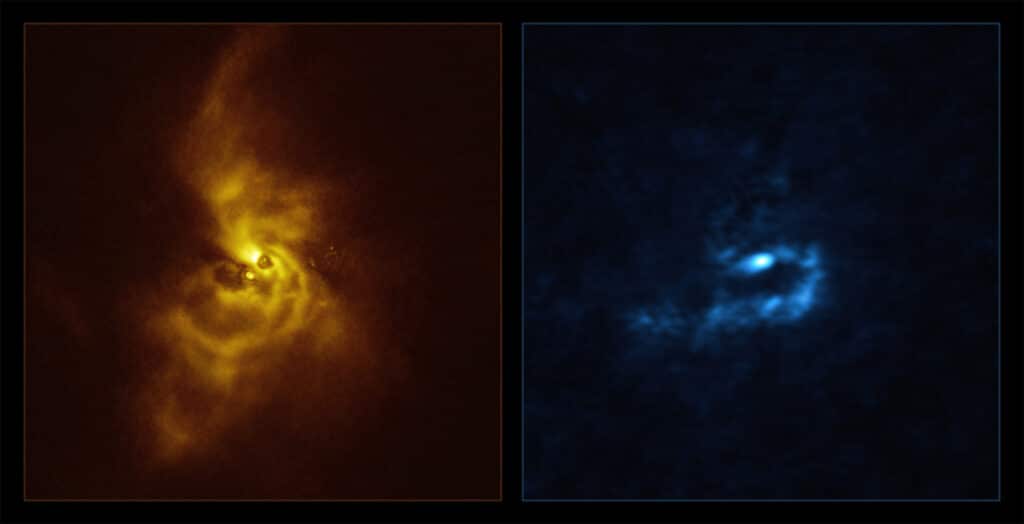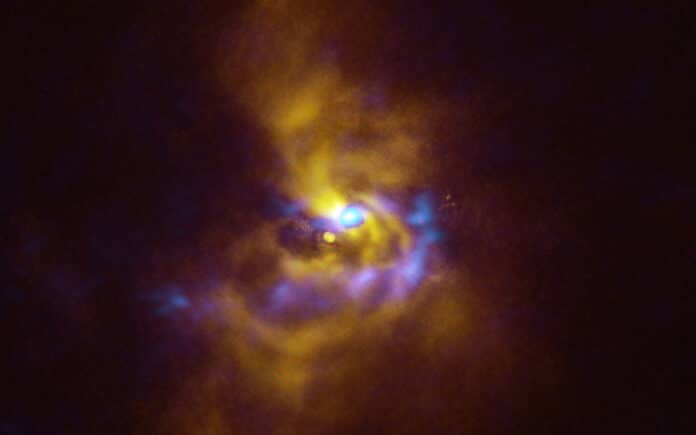A spectacular new image released today by the European Southern Observatory gives us clues about how planets as massive as Jupiter could form. Using ESO’s Very Large Telescope (VLT) and the Atacama Large Millimeter/submillimeter Array (ALMA), researchers have detected large dusty clumps, close to a young star, that could collapse to create giant planets.
“This discovery is truly captivating as it marks the very first detection of clumps around a young star that have the potential to give rise to giant planets,” says Alice Zurlo, a researcher at the Universidad Diego Portales, Chile, involved in the observations.
The work is based on a mesmerising picture obtained with the Spectro-Polarimetric High-contrast Exoplanet REsearch (SPHERE) instrument on ESO’s VLT that features fascinating detail of the material around the star V960 Mon. This young star is located over 5000 light-years away in the constellation Monoceros and attracted astronomers’ attention when it suddenly increased its brightness more than twenty times in 2014. SPHERE observations taken shortly after the onset of this brightness ‘outburst’ revealed that the material orbiting V960 Mon is assembling together in a series of intricate spiral arms extending over distances bigger than the entire Solar System.
This finding then motivated astronomers to analyse archive observations of the same system made with ALMA, in which ESO is a partner. The VLT observations probe the surface of the dusty material around the star, while ALMA can peer deeper into its structure. “With ALMA, it became apparent that the spiral arms are undergoing fragmentation, resulting in the formation of clumps with masses akin to those of planets,” says Zurlo.

Astronomers believe that giant planets form either by ‘core accretion’, when dust grains come together, or by ‘gravitational instability’, when large fragments of the material around a star contract and collapse. While researchers have previously found evidence for the first of these scenarios, support for the latter has been scant.
“No one had ever seen a real observation of gravitational instability happening at planetary scales — until now,” says Philipp Weber, a researcher at the University of Santiago, Chile, who led the study published today in The Astrophysical Journal Letters.
“Our group has been searching for signs of how planets form for over ten years, and we couldn’t be more thrilled about this incredible discovery,” says team-member Sebastián Pérez from the University of Santiago, Chile.
ESO instruments will help astronomers unveil more details of this captivating planetary system in the making, and ESO’s Extremely Large Telescope (ELT) will play a key role. Currently under construction in Chile’s Atacama Desert, the ELT will be able to observe the system in greater detail than ever before, collecting crucial information about it. “The ELT will enable the exploration of the chemical complexity surrounding these clumps, helping us find out more about the composition of the material from which potential planets are forming,” concludes Weber.
Journal Reference
- Philipp Weber, et. al. Spirals and clumps in V960 Mon: signs of planet formation via gravitational instability around an FU Ori star? The Astrophysical Journal Letters DOI: 10.3847/2041-8213/ace186
